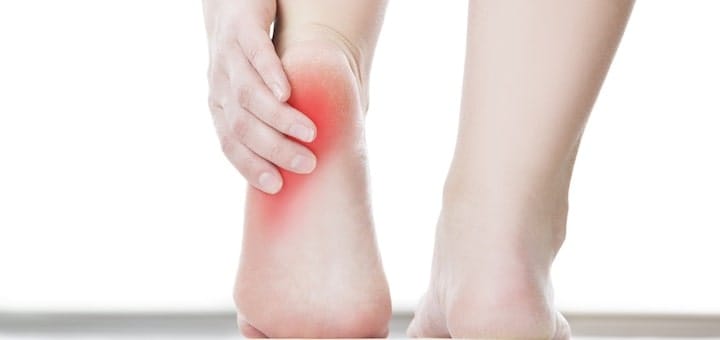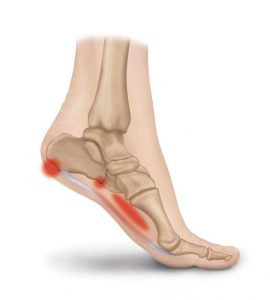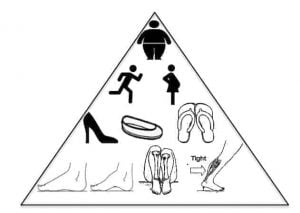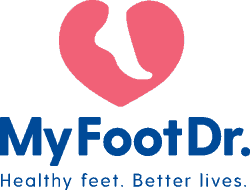
 Commonly known as heel pain, Plantar Fasciitis is a degenerative condition of a ligament called the “Plantar Fascia”. The Plantar Fascia runs from the heel to the ball of the foot and helps to support the arch of the foot. Often, when it gets overstretched or strained, it becomes painful, irritated, inflamed and weaker due to microtears within the ligament secondary to repetitive microtrauma.
Commonly known as heel pain, Plantar Fasciitis is a degenerative condition of a ligament called the “Plantar Fascia”. The Plantar Fascia runs from the heel to the ball of the foot and helps to support the arch of the foot. Often, when it gets overstretched or strained, it becomes painful, irritated, inflamed and weaker due to microtears within the ligament secondary to repetitive microtrauma.
Did you know that approximately one million patients seek help for plantar fasciitis every year?
Symptoms can include:

Risk Factors of Heel Pain
 Anything placing an excessive amount of load and strain through the Plantar Fascia is considered as risk factors and can contribute to the development of plantar fasciitis. Some risk factors include:
Anything placing an excessive amount of load and strain through the Plantar Fascia is considered as risk factors and can contribute to the development of plantar fasciitis. Some risk factors include:
- High/low arch profile/flat feet/overpronation
- Tight calf muscles/poor ankle range of motion
- Limb length difference
- Increased BMI
- Weight gain from pregnancy
- Poor choice of footwear
- Lifestyle (Prolonged standing at work, long-distance running, barefoot walking and running)
- Weak calf complex and intrinsic foot muscles and pelvic/hip instability
Care Management Options for Heel Pain
There are numerous care management options available to manage plantar fasciitis so it completely resolves and heals 100%! However, the longer it is left unmanageed, the longer it takes to resolve and the more aggressive the care management need to be. Conservative therapy is considered the first line of care management and no single care management option alone is perfect. Rather, a combination of conservative care management that are combined holistically work the best to resolve this condition.
- Therapeutic ultrasound and extracorporeal shockwave therapy improve circulation to the site of pathology, which induces an influx of inflammatory mediators and expedites the healing process by stimulating cell repair. Shockwave therapy helps to de-sensitize the injury site along with breaking up scar tissue to promote tissue regeneration.
- Stretching of the calf complex helps reduce tension and load on the plantar fascia.
- Strengthening of the intrinsic foot muscles allows for better movement control and stability within the foot.
- Orthotic devices not only correct the individual’s biomechanics but helps to reduce stress and strain on the plantar fascia with customized modifications catered to the individual.
- Supportive footwear and arch support sandals prevent overstretching of the Plantar Fascia during sports, daily activities, prolonged standing/walking. This is an essential component.
- Night splints and taping keeps the foot in an optimal position to allow healing of the Plantar Fascia by reducing the length of the Plantar Fascia.
-
- Strapping Techniques such as “Low dye” taping help to splint the injured Plantar Fascia
-
- The video below is a live demonstration of a strapping technique that offloads and splints an injured Plantar Fascia ligament
- The video below is a live demonstration of a strapping technique that offloads and splints an injured Plantar Fascia ligament
- Topical and oral NSAIDs (non-steroidal anti-inflammatory) can be taken to reduce inflammation and pain. Oral medication such as Arcoxia or Voltaren. Topical such as Voltaren gel.
- Dry Needling Techniques, Vacuum Cupping and various Manual Therapy, Soft Tissue Techniques can also assist with reducing tension, increasing blood flow and promoting healing. The Podiatrist’s at my FootDr Singapore are all highly skilled in these techniques.
- Lastly, invasive procedures such as corticosteroid injections and surgery should be the last resort. Corticosteroid injections actually cause tissue weakening and can lead to further tearing and damage to the plantar fascia.
Conclusion
We hope that this concise guide to understanding heel pain has been useful to you. If you are experiencing heel pain and it has been causing a significant amount of disruption, it is perhaps time to visit a podiatrist. Here at MyFootDr, we are committed to providing care management with the best quality. If you are in need of care management for your heel pain or professional medical advice with regards to any foot conditions, do feel free to contact us.
